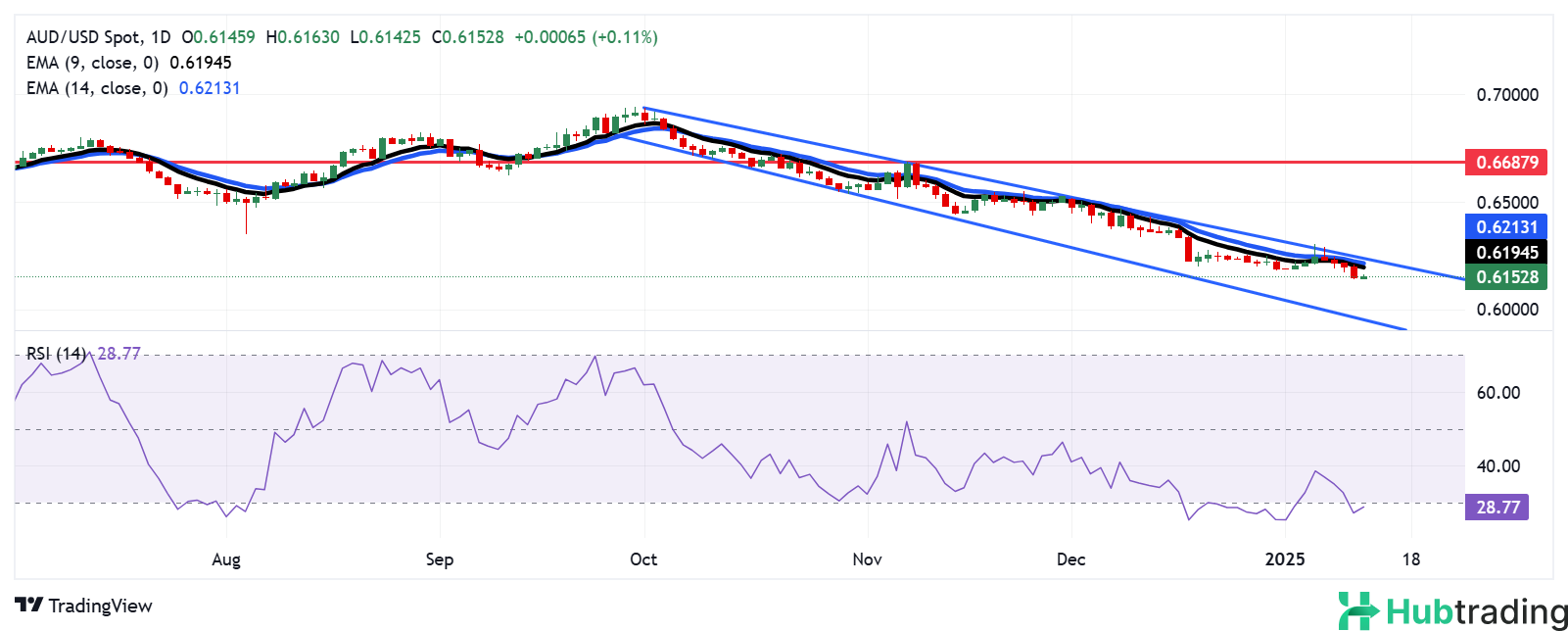- The Australian Dollar continues to weaken as markets price in a 75% probability of an RBA rate cut next month.
- China's trade surplus expanded in December, with the Trade Balance reaching 104.84 billion and Exports rising 10.7% YoY.
- The US Dollar Index surged to 109.98, its highest level since November 2022, driven by strong US labor data.
The Australian Dollar (AUD) continues its decline for the fifth consecutive day against the US Dollar (USD) on Monday, hitting its lowest level since April 2020. The AUD/USD pair faces downward pressure as markets now price in a 75% likelihood of a rate cut by the Reserve Bank of Australia (RBA) next month. Investors are anticipating Australian employment data later this week for further insight into the RBA's monetary policy direction.
The AUD briefly gained traction following the release of the TD-MI Inflation Gauge earlier in the Asian session, which rose by 0.6% month-over-month in December, marking a sharp acceleration from November's 0.2% increase and reaching its highest level since December 2023. On an annual basis, the gauge rose by 2.6%, a slight dip from the previous 2.9% increase.
The Australian Dollar also found some support from China's recent stimulus measures, given the strong economic ties between the two nations. The China Foreign Exchange Committee (CFXC) confirmed its commitment to supporting the Chinese Yuan during a meeting in Beijing, guided by the People's Bank of China (PBOC). In addition, the PBOC and the State Administration of Foreign Exchange (SAFE) announced an increase in the macro-prudential adjustment parameter for cross-border financing, effective January 13, 2025.
China’s trade surplus grew in December, with the Trade Balance reaching $104.84 billion, surpassing expectations of $99.8 billion and the previous balance of $97.44 billion. Exports rose by 10.7% year-over-year, exceeding forecasts of 7.3% and November’s 6.7%, while Imports increased by 1% year-over-year, contrary to the expected 1.5% decline and the previous 3.9% fall.
The Australian Dollar continues to decline as expectations grow that the US Federal Reserve will maintain interest rates this month
- The Australian Dollar (AUD) continues to lose ground amid rising expectations that the US Federal Reserve (Fed) will keep interest rates steady this month. The US Dollar Index (DXY), which tracks the performance of the US Dollar against six major currencies, rose close to 110.00, nearing its highest level since November 2022. This rally comes after strong US labor market data for December, which is expected to bolster the Fed's stance to maintain rates in January.
- Friday's robust US jobs data contributed to a surge in US Treasury yields, with the 2-year and 10-year yields standing at 4.38% and 4.76%, respectively, at the time of writing. The data from the US Bureau of Labor Statistics (BLS) showed Nonfarm Payrolls (NFP) increased by 256K in December, far exceeding market expectations of 160K and surpassing the revised November figure of 212K (previously reported as 227K). The US Unemployment Rate fell to 4.1% in December from 4.2% in November. However, annual wage inflation, measured by Average Hourly Earnings, dipped slightly to 3.9% from 4% in the previous reading.
- Minutes from the latest Federal Open Market Committee (FOMC) meeting indicated that policymakers agreed the tightening process could take longer than anticipated, citing recent stronger-than-expected inflation readings and potential changes in trade and immigration policies under President-elect Trump. Federal Reserve Board of Governors member Michelle Bowman echoed this sentiment, addressing market concerns about the pace of rate cuts in 2025.
- Kansas Fed President Jeffrey Schmid made headlines on Thursday, noting that most of the Fed's mandated targets have been met and emphasizing the need to reduce the Fed’s balance sheet. Schmid suggested that future rate cuts should be gradual and guided by economic data, signaling that interest rate policy may be approaching long-term equilibrium.
- In Australia, ANZ Job Advertisements rose by 0.3% month-over-month in December, recovering from a revised 1.8% decline in November. This suggests that the labor market remains resilient despite elevated interest rates. Meanwhile, the People's Bank of China (PBOC) Governor Pan Gongsheng stated on Monday that interest rate and reserve requirement ratio (RRR) tools will be used to maintain ample liquidity, reaffirming China’s commitment to driving global economic growth.
- In economic data from Australia, the Consumer Price Index (CPI) rose 2.3% year-over-year in November, surpassing the market forecast of 2.2%. This marked an increase from the 2.1% rise in the previous months, making it the highest reading since August. However, the figure remained within the Reserve Bank of Australia's (RBA) target range of 2–3% for the fourth consecutive month, supported by the ongoing impact of the Energy Bill Relief Fund rebate.
The Australian Dollar falls below 0.6150, with a bullish divergence observed on the RSI
The AUD/USD pair is trading around 0.6160 on Monday, maintaining a bearish outlook as it continues to move within a descending channel on the daily chart. The 14-day Relative Strength Index (RSI) is at the 30 level, indicating an oversold condition and suggesting the potential for an upward correction soon.
Support for the AUD/USD pair is likely to be tested at the lower boundary of the descending channel, near the 0.5950 level.
Immediate resistance is found near the nine-day Exponential Moving Average (EMA) at 0.6196, followed by the 14-day EMA at 0.6214. A stronger resistance is located at the upper boundary of the descending channel, around 0.6230.
AUD/USD: Daily Chart






